Indigo revolt

The Indigo revolt (or Nilbidroha) was a peasant movement and subsequent uprising of indigo farmers against the indigo planters that arose in Bengal in 1859.
Causes of the revolt
Indigo planting in Bengal dated back to 1777. Louis Bonard was probably the first indigo planter. With expansion of British power in the Nawabate of Bengal, indigo planting became more and more commercially profitable because of the demand for blue dye in Europe. It was introduced in large parts of Burdwan, Bankura, Birbhum, Murshidabad, etc. The indigo planters left no stones unturned to make money. They mercilessly pursued the peasants to plant indigo instead of food crops. They provided loans, called dadon at a very high interest. Once a farmer took such loans he remained in debt for whole of his life before passing it to his successors. The price paid by the planters was meagre,only 2.5% of the market price. The farmers could make no profit growing indigo. The farmers were totally unprotected from the brutal indigo planters, who resorted to mortgages or destruction of their property if they were unwilling to obey them. Government rules favoured the planters. By an act in 1833, the planters were granted a free hand in oppression. Even the zamindars, money lenders and other influential persons sided with the planters. Out of the severe oppression unleashed on them the farmers resorted to revolt.
The Bengali middle class supported the peasants whole-heartedly. Harish Chandra Mukherjee thoroughly described the plight of the poor peasants in his newspaper The Hindu Patriot. However the articles were overshadowed by Dinabandhu Mitra, who gave an accurate account of the situation in his play "Neel darpan". The play created a huge controversy.
The revolt
The revolt started from Nadia where Bishnucharan Biswas and Digambar Biswas first led the rebellion against the planters. It spread rapidly in Murshidabad, Birbhum, Burdwan, Pabna, Khulna, Narail, etc. Some indigo planters were given a public trial and executed. The indigo depots were burned down. Many planters fled to avoid being caught. The zamindars were also targets of the rebellious peasants.
The revolt was ruthlessly suppressed. Large forces of police and military, backed by the British Government and the zamindars, mercilessly slaughtered a number of peasants. In spite of this, the revolt was fairly popular, involving almost the whole of Bengal. The Biswas brothers of Nadia, Kader Molla of Pabna, Rafique Mondal of Malda were popular leaders. Even some of the zamindars supported the revolt, the most important of whom was Ramratan Mullick of Narail.
The effect on the British rulers in India
The historian Jogesh Chandra Bagal describes the revolt as a non-violent revolution and gives this as a reason why the indigo revolt was a success compared to the Sepoy Revolt. R.C. Majumdar in "History of Bengal"[1] goes so far as to call it a forerunner of the non-violent passive resistance later successfully adopted by Gandhi. The revolt had a strong effect on the government, which immediately appointed the "Indigo Commission" in 1860.[2] In the commission report, E. W. L. Tower noted that "not a chest of Indigo reached England without being stained with human blood".[3] Evidently it was a major triumph of the peasants to incite such emotion in the European's minds. Thus the revolt was a success
Cultural effects
Dinabandhu Mitra's 1859 play Nil Darpan is based on the revolution. It was translated into English by Michael Madhusudan Dutta and published by Rev. James Long. It attracted much attention in England, where the people were stunned at the savagery of their countrymen. The British Government sent Rev. Long to a mock trial and punished him with imprisonment and fine. Kaliprasanna Sinha paid the fine for him.
The play(neel darpan) is the first play to be staged commercially in the National Theatre in Kolkata.
See also
References
- ↑ Majumdar, R. C. The Government in 1860 enacted the Indigo Act, according to which no planter could be forced to cultivate indigo against his will. The History of Bengal ISBN 81-7646-237-3
- ↑ Social Scientist. v 5, no. 60 (July 1977) p. 14.
- ↑ The Calcutta Review. University of Calcutta. 1861-01-01. p. 291.